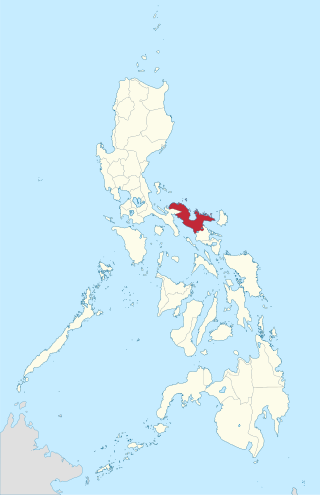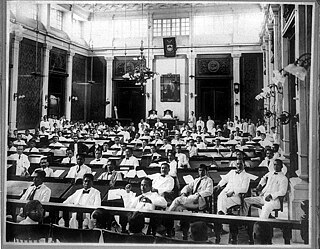Related Research Articles

Ambos Camarines, officially the Province of Ambos Camarines, was a historical province in the Philippines found on the northern end of the Bicol Peninsula. It now exists as two separate provinces: Camarines Norte and Camarines Sur.
The legislative districts of Apayao are the representations of the province of Apayao in the various national legislatures of the Philippines. The province is currently represented in the lower house of the Congress of the Philippines through its lone congressional district.
The legislative districts of Ambos Camarines were the representations of the historical province of Ambos Camarines in the various national legislatures of the Philippines until 1919.
The legislative districts of Pampanga are the representations of the province of Pampanga and the highly urbanized city of Angeles in the various national legislatures of the Philippines. At present, the province and the city are represented in the House of Representatives of the Philippines by its four congressional districts.
The legislative districts of the Philippines are the divisions of the Philippines' provinces and cities for representation in the various legislative bodies. Congressional districts are for House of Representatives, while there are districts for Sangguniang Panlalawigan, and some Sangguniang Panlungsod. For purposes of representation, the Senate, most Sangguniang Panlungsod, Sangguniang Bayan, Sangguniang Barangay and Sangguniang Kabataan are all elected at-large, although there were districts for the Senate from 1916 to 1935.

The Fourth Philippine Legislature was the meeting of the legislature of the Philippine Islands under the sovereign control of the United States from October 16, 1916, to March 8, 1919.

The senatorial districts of the Philippines were the representations of the provinces of the Philippines in the Philippine Senate from 1916 to 1935.
José Tria Fuentebella, widely known as "Pepe", was a Filipino politician. He is the first Fuentebella to foray into the national arena of politics.
Philippines's 1st senatorial district, officially the First Senatorial District of the Philippine Islands, was one of the twelve senatorial districts of the Philippines in existence between 1916 and 1935. It elected two members to the Senate of the Philippines, the upper chamber of the bicameral Philippine Legislature under the Insular Government of the Philippine Islands for each of the 4th to 10th legislatures. The district was created under the 1916 Jones Law from the northern Luzon provinces of Batanes, Cagayan, Ilocos Norte, Ilocos Sur and Isabela. Abra was added in 1917 upon its re-establishment as a regular province separate from Ilocos Sur.
Philippines's 2nd senatorial district, officially the Second Senatorial District of the Philippine Islands, was one of the twelve senatorial districts of the Philippines in existence between 1916 and 1935. It elected two members to the Senate of the Philippines, the upper chamber of the bicameral Philippine Legislature under the Insular Government of the Philippine Islands for each of the 4th to 10th legislatures. The district was created under the 1916 Jones Law from the west-central Luzon provinces of La Union, Pangasinan and Zambales.
Philippines's 3rd senatorial district, officially the Third Senatorial District of the Philippine Islands, was one of the twelve senatorial districts of the Philippines in existence between 1916 and 1935. It elected two members to the Senate of the Philippines, the upper chamber of the bicameral Philippine Legislature under the Insular Government of the Philippine Islands for each of the 4th to 10th legislatures. The district was created under the 1916 Jones Law from the east-central Luzon provinces of Bulacan, Nueva Ecija, Pampanga and Tarlac.
Philippines's 4th senatorial district, officially the Fourth Senatorial District of the Philippine Islands, was one of the twelve senatorial districts of the Philippines in existence between 1916 and 1935. It elected two members to the Senate of the Philippines, the upper chamber of the bicameral Philippine Legislature under the Insular Government of the Philippine Islands for each of the 4th to 10th legislatures. The district was created under the 1916 Jones Law from the capital Manila and adjacent provinces in south-central Luzon, namely Bataan, Laguna and Rizal.
Philippines's 5th senatorial district, officially the Fifth Senatorial District of the Philippine Islands, was one of the twelve senatorial districts of the Philippines in existence between 1916 and 1935. It elected two members to the Senate of the Philippines, the upper chamber of the bicameral Philippine Legislature under the Insular Government of the Philippine Islands for each of the 4th to 10th legislatures. The district was created under the 1916 Jones Law from the southern Luzon provinces of Batangas, Cavite, Mindoro and Tayabas. Marinduque was added in 1920 upon its re-establishment as a regular province separate from Tayabas.
Philippines's 7th senatorial district, officially the Seventh Senatorial District of the Philippine Islands, was one of the twelve senatorial districts of the Philippines in existence between 1916 and 1935. It elected two members to the Senate of the Philippines, the upper chamber of the bicameral Philippine Legislature under the Insular Government of the Philippine Islands for each of the 4th to 10th legislatures. The district was created under the 1916 Jones Law from the western Visayas provinces of Capiz and Iloilo. Romblon was added in 1917 upon its re-establishment as a regular province separate from Capiz.
Philippines's 8th senatorial district, officially the Eighth Senatorial District of the Philippine Islands, was one of the twelve senatorial districts of the Philippines in existence between 1916 and 1935. It elected two members to the Senate of the Philippines, the upper chamber of the bicameral Philippine Legislature under the Insular Government of the Philippine Islands for each of the 4th to 10th legislatures. The district was created under the 1916 Jones Law from the western Visayas provinces of Antique, Negros Occidental, Negros Oriental and Palawan.
Philippines's 9th senatorial district, officially the Ninth Senatorial District of the Philippine Islands, was one of the twelve senatorial districts of the Philippines in existence between 1916 and 1935. It elected two members to the Senate of the Philippines, the upper chamber of the bicameral Philippine Legislature under the Insular Government of the Philippine Islands for each of the 4th to 10th legislatures. The district was created under the 1916 Jones Law from the eastern Visayas provinces of Leyte and Samar.
Philippines's 10th senatorial district, officially the Tenth Senatorial District of the Philippine Islands, was one of the twelve senatorial districts of the Philippines in existence between 1916 and 1935. It elected two members to the Senate of the Philippines, the upper chamber of the bicameral Philippine Legislature under the Insular Government of the Philippine Islands for each of the 4th to 10th legislatures. The district was created under the 1916 Jones Law from the central Visayas province of Cebu.
Philippines's 11th senatorial district, officially the Eleventh Senatorial District of the Philippine Islands, was one of the twelve senatorial districts of the Philippines in existence between 1916 and 1935. It elected two members to the Senate of the Philippines, the upper chamber of the bicameral Philippine Legislature under the Insular Government of the Philippine Islands for each of the 4th to 10th legislatures. The district was created under the 1916 Jones Law from the central Visayas province of Bohol and the northern Mindanao provinces of Misamis and Surigao. Misamis was split into the provinces of Misamis Occidental and Misamis Oriental in 1929.
Philippines's 12th senatorial district, officially the Twelfth Senatorial District of the Philippine Islands, was one of the twelve senatorial districts of the Philippines in existence between 1916 and 1935. Unlike the first eleven districts which elected two members each to the Senate of the Philippines, the upper chamber of the bicameral Philippine Legislature under the Insular Government of the Philippine Islands, the two senators from this district were appointed by the Governor-General of the Philippines to serve indefinite terms in the 4th to 10th legislatures. The district was created under the 1916 Jones Law to represent the non-Christian tribes of the northern Luzon provinces of Mountain Province and Nueva Vizcaya, the city of Baguio, and the Moro people and other non-Christian tribes of the Department of Mindanao and Sulu provinces of Agusan, Bukidnon, Cotabato, Davao, Lanao, Sulu and Zamboanga.
Camarines Norte's at-large congressional district refers to the lone congressional district of the Philippines in the province of Camarines Norte for various national legislatures before 2010. The province first elected its representatives provincewide at-large in 1919 following the dissolution of Ambos Camarines into the present provinces of Camarines Norte and Camarines Sur. It was a single-member district for the final six legislatures of the Insular Government of the Philippine Islands from 1919 to 1935, the three legislatures of the Commonwealth of the Philippines from 1935 to 1946, the seven congresses of the Third Philippine Republic from 1946 to 1972, the national parliament of the Fourth Philippine Republic from 1984 to 1986, and the 8th to 14th congresses of the Fifth Philippine Republic from 1987 to 2010.
References
- ↑ United States Congressional Serial Set. U.S. Government Printing Office. 1918. pp. 37–38. Retrieved May 12, 2020.
- ↑ "List of previous senators". Senate of the Philippines . Retrieved May 12, 2020.
- ↑ "Roster of Philippine Senators". Official Gazette (Philippines) . Retrieved May 12, 2020.